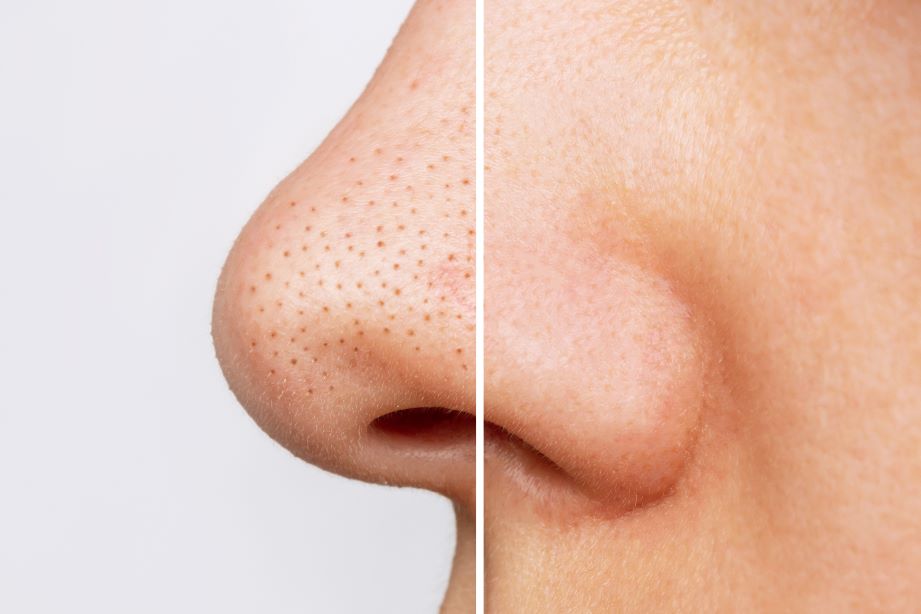Many skin conditions have very similar symptoms, and it can be difficult to tell them apart if you don’t have the right training and experience to distinguish the subtle differences. However, receiving an accurate diagnosis is essential to ensure you establish the right treatment plans. Blackheads and sebaceous filaments are two very similar skin conditions that are often misdiagnosed, but they require different skincare and treatments. According to Dr. David Baltazar of U.S. Dermatology Partners in Peoria and Sun City West, Arizona, “Both sebaceous filaments and blackheads are relatively common skin conditions that produce small blemishes on the skin. However, blackheads develop as a result of clogged pores and sebaceous filaments are a natural outlet for the body’s oils.” In this blog, Dr. Baltazar compares blackheads vs. sebaceous filaments and explores the differences between blackheads and sebaceous filaments as well as how they should be treated differently.
Deciphering the Confusion: Blackheads vs. Sebaceous Filaments
Both blackheads and sebaceous filaments appear as small blemishes on the skin. In most cases, they develop on the face, specifically around the nose, forehead, and chin. However, blackheads and sebaceous filaments can form on almost any part of the body. They look and feel very similar on the surface of the skin, but these two common skin health concerns are actually very different. They also require different skincare and treatments.
What are Blackheads?
Blackheads or open comedones are a form of acne. They appear as dark bumps on the surface of the skin. Sometimes, they look flat and aren’t painful. Otherwise, excess oils, dead skin, bacteria, and other matter can become trapped beneath the blackhead, creating an inflamed pimple. The body expels oil through the pores onto the skin to keep it moisturized. When a blackhead forms, that oil isn’t able to travel to the surface of the skin. Not only does that lead to a pimple, but it can also cause dryness in the surrounding area. When squeezed, the blackhead will “pop,” expelling any underlying oils and matter and the dark plug.
Understanding Sebaceous Filaments
Sebaceous filaments are a natural structural part of our pores. They’re microscopic tubes that allow sebum, the body’s naturally produced oil, to run from the sebaceous glands where sebum is produced to the surface of the skin. This keeps skin hydrated and moisturized, giving it a smooth, healthy glow. Up close, sebaceous filaments may look a bit like a blackhead, especially if pores are enlarged or the sebaceous glands are over-producing sebum oils. When people squeeze sebaceous filaments, they are likely to produce an oily, thread of sebum. This oily substance may be mistaken for a popped blackhead, which can be similar in texture. However, there will not be a darker spot created by the blackhead plug, the produced material is usually lighter in color, and there will usually be no sign of infection or inflammation. They will not feel painful to the touch or cause discomfort. Like blackheads, sebaceous filaments are often noticeable in the T zone (forehead, nose, and chin). While everyone has sebaceous filaments, they look more noticeable if:
- Enlarged pores reveal more of the sebaceous filament.
- During puberty and other times of hormonal fluctuation, increased sebum oil production may lead to more noticeable sebaceous filaments.
- Aging skin can become loose and saggy. This makes pores appear naturally larger drawing attention to sebaceous filaments.
- Those with thicker hair may have more noticeable sebaceous filaments because the follicles are larger to accommodate the thicker strands of hair.
- Those who have naturally dry skin, wash too frequently, use harsh skincare products, or spend too much time in the sun, may have overproductive sebaceous glands that are more noticeable.
Key Differences: Blackheads and Sebaceous Filaments Side-by-Side
Some of the key differences between blackheads and sebaceous filaments include:
- Cause – Blackheads are a type of acne that creates an open, clogged pore. Sebaceous filaments are a natural part of the pore structure.
- Size – Blackheads are often small, black dots on the skin, but they can grow significantly larger. Sebaceous filaments usually remain small.
- Color – Blackheads, as the name suggests, usually have dark coloring at the top, but sebaceous filaments are typically much lighter in color. Additionally, the color is not darker at the top like blackheads.
- Texture – Blackheads are slightly raised bumps, and they may feel hard on the top. Sebaceous filaments typically feel smooth and are flat to the skin.
- Healing – Blackheads can be extracted, and once they heal, they will not necessarily re-form. Because sebaceous filaments are a natural part of the body’s pore structures, without the proper care, they won’t heal and shrink even if the sebum is extracted.
Skincare for Each Skin Concern
When it comes to skincare to treat blackheads and sebaceous filaments, Dr. Baltazar says, “While these two skin conditions are very different, they can both be improved with a similar approach to skincare that focuses on increasing skin cell turnover, reducing oil production, and shrinking pores. However, it’s always best to work with a dermatologist to develop a personalized skincare routine tailored to your unique needs.” Below, Dr. Baltazar has outlined an ideal skincare routine to heal blackheads and reduce the appearance of sebaceous filaments:
Morning Skincare:
- Cleansing – A gentle cleanser is essential for reducing the size of pores, cleaning out pores, and reducing oiliness. You may want to choose a cleanser with salicylic acid. This active ingredient is often recommended for acne because it dissolves dead skin cells and opens up clogged pores, making it ideal for blackheads. Additionally, salicylic acid is beneficial in reducing the size of pores, which means it also decreases the appearance of sebaceous filaments. SkinCeuticals LHA Cleansing Gel is one of the best salicylic acid cleansers on the market. It provides a complete clean that’s also gentle for minimal irritation.
- Exfoliation – A good exfoliant increases skin cell turnover to reduce the risk of clogged pores. Regularly removing dead skin cells also helps to keep skin moisturized. This means reduced sebum production, which keeps sebaceous filaments clear. Most people don’t necessarily need to exfoliate every day, especially those who have sensitive skin. Instead, exfoliating a few times each week is typically adequate.
- Toner – In conjunction with cleanser and exfoliant, toner keeps skin completely clean and balances pH. This reduces inflammation and keeps skin moisturized without being oily. Toner also helps the skin to readily absorb other products.
- Serums – Choose a good vitamin C serum to utilize as part of your daily routine. These products help to prevent sun damage and keep skin bright and healthy.
- Moisturizer – Without adequate moisture, the skin will continue to produce additional sebum to restore adequate hydration. This makes skin oilier. For this reason, it’s important to apply adequate moisturizer to the skin.
- Sunscreen – Sun damage can cause numerous skin health issues, including making acne worse, causing inflammation, and drying out skin. Protecting skin from sun damage by applying sunscreen every day is essential.
Evening Skincare:
- Cleanser – The same simple cleanser can be used as part of the morning and evening skincare routine.
- Toner – Those struggling with blackheads and sebaceous filaments will benefit from using toner in the morning and evening to balance skin.
- Retinol – These vitamin A derivatives are beneficial to increase skin cell turnover to shrink pore size, making sebaceous filaments less noticeable and reducing the risk of blackheads.
- Moisturizer – In the evenings, choose a thick, calming moisturizer to keep your skin healthy and hydrated.
Empowering Your Skincare Journey with Knowledge
According to Dr. Baltazar, “Knowing exactly what your skin needs empowers you to make the best choices to ensure skin is both healthy and beautiful at every stage of life. Working with a dermatologist, you can explore all of the factors that impact your skin’s health and appearance, including skin type, chronic skin conditions, and aging. By pinpointing these variables, your dermatologist can make recommendations for the best at-home skincare routines and products. The more you know, the better able you’ll be to care for your skin.”
Learn More from a Dermatologist
Whether you’re struggling with over-producing sebaceous filaments, blackheads, or just about any other skin health concern, a dermatologist can help you develop a skincare routine to look and feel your very best. If you’re interested in talking to one of our knowledgeable dermatologists, don’t hesitate to reach out to the team at U.S. Dermatology Partners to schedule a consultation visit. It’s easy to get started. Take a few moments to fill out our online scheduling request form, and one of our local practices will be in touch to answer your questions and finalize the details of your appointment.
Find a location near me
or


